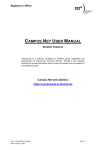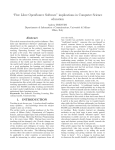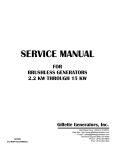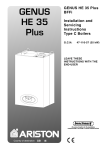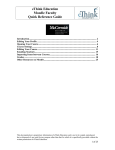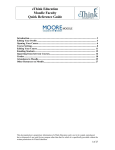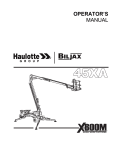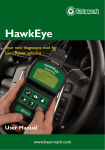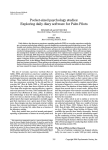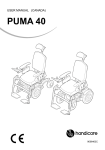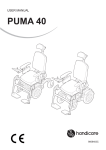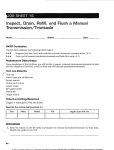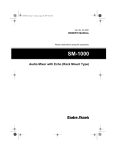Download VI. Integrated Curriculum Standards and Technical Competencies
Transcript
HELP Automotive Service Technology A5 Automotive Brake Systems HELP © 1999 CORD Published by: CORD Communications, Inc. P.O. Box 21206 Waco, Texas 76702-1206 (254) 776-1822 (800) 231-3015 for Automotive Youth Educational Systems 2701 Troy Center Drive Suite 450 Troy, Michigan 48084 248-273-1200 www.ayes.org Printed in the United States of America July 1999, January 2000 ISBN 1-57837-242-9 Table of Contents HELP Course Syllabus A5 AUTOMOTIVE BRAKE SYSTEMS A Secondary-Level Course for Students Interested in Careers Related to Automotive Brake Systems This course links occupational and academic pedagogy and is built on Integrated Curriculum Standards, which incorporate state and national academic, occupational, and employability standards. Contents I. II. III. IV. V. VI. VII. VIII. IX. X. XI. XII. Course Title Course Duration Course Description Course Instructional Philosophy, Purpose, and Methodology Course Objectives Integrated Curriculum Standards and Technical Competencies Addressed in This Course Active Learning—Ideas for Application Active Learning—Projects/Labs (Job Sheets) Active Learning—Worksite Options Assessment Strategy Options Suggested Textbooks/References Outline of Course Content A5 Automotive Brake Systems 1 HELP I. Course Title A5 Automotive Brake Systems II. Course Duration One year (1 Carnegie unit) depending on the allowable school time blocks III. Course Description A specific technical course designed to teach the principles of automotive hydraulic brake systems. This course builds on the essential laws of physics, motion, forces, hydraulics, thermodynamics, and chemical reactions and how these principles apply to the operation and diagnosis of automotive brake systems. This course will cover the energy conversion of motion changed to heat energy (when you apply brakes), the effects of weight and speed on braking and stopping distance, thermal expansion, friction, force, and coefficient of friction as they apply to braking systems. Courseware covers the fundamentals and service of disc/drum brakes including how they operate, brake-fluid properties, diagnosis, component replacement/repair/adjustment, disc/drum machining, and power-assist units; and the fabrication (ISO or double flaring) of brake lines. The course will also cover computer-controlled antilocking brake system (ABS) operation and diagnosis. The student will learn strategy-based diagnostic routines for interpreting and verifying customer concerns and proper operation. The student will perform tests and inspection using special tools and scan tools to determine the causes of problems and make corrections related to hydraulic brakes and will communicate electronically with antilock brake systems (ABS). Through the inspection, testing, or measurement of components process, the student will learn to apply this knowledge to determine needed repairs and repair vehicle. Courseware will also include specific instructions for the worksite mentor trainer. Prerequisite: Technology Systems, Fundamentals of Service Technology, A6 Electrical/Electronic. Corequisite: Contextual Physics. A5 Automotive Brake Systems 2 Table of Contents HELP IV. Course Instructional Philosophy, Purpose, and Methodology This course will focus on student mastery of selected basic principles and the use of equipment that is fundamental to brake systems and antilock brake systems (ABS) in the automotive industry. Skill mastery will depend on performance of the listed technical competencies used as criterion references. In this course, the student will apply the theories of mechanics and physics that are learned in the corequisite course in physics, and will build on the introductory work in technology systems and service technology done in the prerequisite courses. The content of this course is intended to develop the student’s understanding of complex hydraulic braking and computer-controlled antilock systems through the contextual learning principles of transferring, relating, application, cooperation, and experience. V. Course Objectives The objectives for this course are as follows: 1. The student will master specified academic and technical content. 2. The student will practice effective communication skills. 3. The student will develop abilities to solve problems and think skillfully. 4. The student will practice skills required for working within a system. 5. The student will learn to manage resources and information. 6. The student will practice skills required for being a responsible person. A5 Automotive Brake Systems 3 Table of Contents HELP VI. Integrated Curriculum Standards and Technical Competencies Addressed in This Course Upon completion of this course, students are expected through system understanding to diagnose, repair, and/or service car and truck disc/drum hydraulic brake and antilock brake (ABS) systems to original equipment manufacturer’s (OEM) specifications. These expectations are defined in terms of integrated academic, employability, and occupational standards represented by Integrated Curriculum Standards (ICS) plus detailed technical competencies. Technical competencies specify the technical knowledge and skills that are required to diagnose, repair, and service automotive hydraulic brake and antilock brake systems. ICSs incorporate the national academic, employability, and occupational standards that should be considered in this course. With use of the ICSs, integration of academic and technical content can be accomplished. The ICSs introduce topics that go beyond the technical content and address expectations for students to develop a variety of complex skills. Additional information about the ICSs can be obtained from the Curriculum Integrator materials. See Section XI for the reference information. Some connections to job sheets and ideas for application are given as examples of repairs and tasks performed in the various technology areas. Students will see the connections among the ideas for application, job sheets, worksite mentored activities, and various competencies and standards listed, because all activities are task/competency based and tied to the ICSs. Information provided in this syllabus is not only for instructor use, but can also provide value to the students and should be provided to them. A5 Automotive Brake Systems 4 Table of Contents HELP VI. Integrated Curriculum Standards and Technical Competencies Addressed in This Course Course Objective 1:The student will master specified academic and technical content. Ideas for Projects/Labs Worksite Application (Job Sheets) Options Videotapes and two-way audio/video provide safe ways to observe the correct handling of chemicals. Standards and Competencies ICS 005 Chemical Reactions Identify, describe, and perform basic types of chemical reactions: synthesis, redox, addition, displacement, and decomposition. Investigate selected processes that occur in these contexts. Analyze the processes in order to classify the types of reactions involved. Perform, monitor, and describe the basic types of reactions in the laboratory using appropriate equipment and giving attention to all safety and health factors in these reactions. Analyze reactions from both the “real-world” and the laboratory viewpoints. Identify reactants and products and the stoichiometric relationship between them in the balancing of equations. In all the above activities, use appropriate chemical nomenclature to name substances and describe reactions. Assessment Strategy Options ICS assessment instrument On-demand demonstration Technical Competencies ! ! Explain energy, heat, temperature, and pressure and identify their place in automotive braking systems. Select, handle, store, and install brake fluids to proper level. A5 Automotive Brake Systems 5 Table of Contents HELP VI. Integrated Curriculum Standards and Technical Competencies Addressed in This Course Course Objective 1:The student will master specified academic and technical content. Ideas for Projects/Labs Worksite Application (Job Sheets) Options Professional help in projects, consulting with mentors, and internships can show examples of this skill. Standards and Competencies ICS 007 Chemical and Physical Properties Identify and measure physical and chemical properties of matter, including various spectra, carrying out standardized tests and observations, and using standard chemical references and/or databases where appropriate to obtain data on properties of test materials. Make connections between certain physical properties and states of matter. Make connections between molecular structure and chemical properties such as oxidizing and reducing properties and acidity and alkalinity. Use chemical and physical properties to purify reaction products and other compounds. Assessment Strategy Options ICS assessment instrument, Structured observation Work journal entry Technical competencies ! ! ! ! Define the characteristics of liquids. Explain the properties of automotive brake fluid Identify the terms associated with automotive brake fluid and explain their definitions. Select, handle, store, and install brake fluids to proper level. NATEF Work Skill A5/A7. A5 Automotive Brake Systems 6 Table of Contents HELP VI. Integrated Curriculum Standards and Technical Competencies Addressed in This Course Course Objective 1:The student will master specified academic and technical content. Ideas for Projects/Labs Worksite Application (Job Sheets) Options Worksite learning plans should incorporate this topic. Students can use worksite situations as foundations for projects. Standards and Competencies ICS 091 Microprocessor Systems and Interfaces Identify and interpret principles and operations of microprocessors and external devices. Apply logical and systematic approaches to analyze, design or service, fabricate or repair, test, troubleshoot, and service or repair microprocessor circuits, observing rules and techniques of accepted industry workmanship and safety standards including electrostatic discharge (ESD) safety. Technical Competencies ! Describe the function and basic operation of a microprocessor. Describe the types of automotive computer input and output signals. A5 Automotive Brake Systems Assessment Strategy Options ICS assessment instrument Cognitive mapping ASE-style paper-andpencil test 7 Table of Contents HELP VI. Integrated Curriculum Standards and Technical Competencies Addressed in This Course Course Objective 1:The student will master specified academic and technical content. Ideas for Projects/Labs Worksite Application (Job Sheets) Options Science Projects 2, 3, and 5 Professional help in projects, consulting with mentors, and internships can show examples of this skill. Standards and Competencies ICS 101 Basic Physics Identify and interpret the meaning of basic physics concepts of mechanics, forces, thermodynamics, heat, electricity, magnetism, optics, wave motion, acoustics, and atomic and nuclear physics. Apply these concepts in technology. Technical Competencies ! ! ! ! Assessment Strategy Options ICS assessment instrument ASE-style paper-andpencil test Explain friction, force, inertia, momentum, speed, work, torque, and power. Apply these terms to automotive brake systems. Define the coefficient of friction. Explain energy, heat, temperature, and pressure and how they relate to automotive braking. Explain atmospheric pressure and identify the relationship to the term vacuum. A5 Automotive Brake Systems 8 Table of Contents HELP VI. Integrated Curriculum Standards and Technical Competencies Addressed in This Course Course Objective 1:The student will master specified academic and technical content. Ideas for Projects/Labs Worksite Application (Job Sheets) Options Projects 3 and 4 Professional help in projects, consulting with mentors, and internships can show examples of this skill. Standards and Competencies ICS 102 Mechanics and Forces Identify and interpret the meaning of the relevant units of mechanical forces. Apply the laws of motion, conservation of energy, types of forces, concepts of levers and torque, angular momentum, and gravitational forces. Technical Competencies ! ! Projects 1, 2, and 3 Professional help in projects, consulting with mentors, and internships can show examples of this skill. ICS assessment instrument ASE-style paper-andpencil test Explain Newton’s laws of motion and identify which concepts of mass, force, and acceleration apply to automotive braking. Explain the energy conversion of motion changed to heat energy. ICS 103 Thermodynamics and Heat Identify and interpret the relevant units of thermodynamics/heat, phases of matter, the ideal gas law, temperature, heat transfer, and energy measurement. Technical Competencies ! ! ! Assessment Strategy Options Explain thermal expansion of fluids, gases, and solids. Explain energy, heat, temperature, and pressure. Identify the thermodynamic principles that apply to automotive braking. A5 Automotive Brake Systems ICS assessment instrument ASE-style paper-andpencil test 9 Table of Contents HELP VI. Integrated Curriculum Standards and Technical Competencies Addressed in This Course Course Objective 1:The student will master specified academic and technical content. Ideas for Projects/Labs Worksite Application (Job Sheets) Options Projects 3 and 5 Job shadowing, part-time employment, and internships can give firsthand experience with this skill. Standards and Competencies ICS 157 Hydraulic Brake Systems Identify and interpret the operation of hydraulic brake systems. Diagnose and repair malfunctions in hydraulic brake systems. Technical Competencies ! ! ! ! ! ! ! ! ! ! Define basic brake requirements. Explain the effects of weight and speed on braking and stopping distance. Interpret how the laws of hydraulics apply to automotive brake systems. Identify the plumbing components of the brake system. Identify the different types of master cylinders and explain their operation. Explain the operation of the split brake system. Check master cylinder for internal and external leaks and proper operation; determine necessary action. NATEF Work Skill A5/A2, P2. Remove, bench bleed, and reinstall master cylinder. NATEF Work Skill A5/A3, P1. Identify the terms associated with automotive brake bleeding and explain their definitions. Bleed (manual pressure, vacuum, or surge) brake system; flush hydraulic system. NATEF Work Skill A5/A11, 12. P1 A5 Automotive Brake Systems Assessment Strategy Options ICS assessment instrument On-demand demonstration 10 Table of Contents HELP VI. Integrated Curriculum Standards and Technical Competencies Addressed in This Course Course Objective 1:The student will master specified academic and technical content. Ideas for Projects/Labs Worksite Application (Job Sheets) Options Standards and Competencies Assessment Strategy Options ICS 157 Competencies Continued ! ! ! Fabricate and install brake lines (double-flare and ISO types); replace hoses, fittings, and supports as needed. NATEF Work Skill A5/A6. Check operation of brake stop light system; adjust and service as needed. NATEF Work Skill A5/E6, P1. Inspect, test, replace, and adjust height (load) sensing proportioning valve. NATEF Work Skill A5/A9, P3. A5 Automotive Brake Systems 11 Table of Contents HELP VI. Integrated Curriculum Standards and Technical Competencies Addressed in This Course Course Objective 1:The student will master specified academic and technical content. Ideas for Projects/Labs Worksite Application (Job Sheets) Options Math Projects 3, 4, and 5 Job shadowing, part-time employment, and internships can give firsthand experience with this skill. Standards and Competencies ICS 158 Drum/Disc Brakes and Power-Assist Units Assessment Strategy Options ICS assessment instrument Identify and interpret the operation of drum/disc brakes and powerassist units. Diagnose and repair malfunctions in drum/disc brakes On-demand and power-assist units. demonstration Technical Competencies ! ! ! ! ! ! Identify foundation brake components and explain their operation. Identify the components and types of parking brakes and explain their operation. Identify components and types of power assist units and explain their operation. Mount brake drum on lathe; machine braking surface NATEF Work Skill A5/B3, P2. Remove, clean, and inspect brake shoes, springs, pins, clips, levers, adjusters/self-adjusters, other related brake hardware, and backing support plates; lubricate and reassemble. NATEF Work Skill A5/B4, P2. Remove and reinstall wheel cylinders. NATEF Work Skill A5/B5, P2. A5 Automotive Brake Systems 12 Table of Contents HELP VI. Integrated Curriculum Standards and Technical Competencies Addressed in This Course Course Objective 1:The student will master specified academic and technical content. Ideas for Projects/Labs Worksite Application (Job Sheets) Options Standards and Competencies Assessment Strategy Options ICS 158 Technical Competencies continued. ! ! ! ! ! ! ! Preadjust brake shoes and parking brake before installing brake drums or drum/hub assemblies and wheel bearings. NATEF Work Skill A5/B6, P1. Remove the caliper assembly from mountings; clean and inspect for leaks and damage to caliper housing; determine necessary action. NATEF Work Skill A5/C2, P1. Clean and inspect caliper mounting and slides for wear and damage; determine necessary action. NATEF Work Skill A5/C3, P1. Remove, clean, and inspect pads and remaining hardware; determine necessary action. NATEF Work Skill A5/C4, P1. Disassemble and clean caliper assembly; inspect parts for wear, rust scoring, and damage; replace seal, boot, and damaged or worn parts; determine needed repair; and reassemble caliper. NATEF Work Skill A5/C5, C6, P1. Clean, inspect, and measure rotor with a dial indicator and a micrometer; follow manufacturer’s recommendations in determining need to machine or replace. NATEF Work Skill A5/C7, P1. Refinish rotor according to manufacturer's recommendations. NATEF Work Skill A5/C8, P1. A5 Automotive Brake Systems 13 Table of Contents HELP VI. Integrated Curriculum Standards and Technical Competencies Addressed in This Course Course Objective 1:The student will master specified academic and technical content. Ideas for Projects/Labs Worksite Application (Job Sheets) Options Standards and Competencies Assessment Strategy Options ICS 158 Technical Competencies continued ! ! ! ! ! ! ! ! ! ! Adjust calipers with integrated parking-brake system. NATEF Work Skill A5/C9, P3. Install wheel, torque lug nuts, and make final checks and adjustments. NATEF Work Skill A5/C10, P1. Remove and replace rotor. NATEF Work Skill A5/C11, P2. Test pedal free travel with and without engine running; check power assist operation. NATEF Work Skill A5/D1, P2. Check vacuum supply (manifold or auxiliary pump) to vacuumtype power booster. . NATEF Work Skill A5/D2, P2. Remove, clean, inspect, repack, and reinstall wheel bearings and replace seals; reinstall hub and adjust wheel bearings. NATEF Work Skill A5/E2, P1 Check parking-brake cables and components for wear, rusting, binding, and corrosion; clean, lubricate, and replace as needed. NATEF Work Skill A5/E3, P2. Check parking-brake operation; adjust as needed. NATEF Work Skill A5/E4, P1. Check operation of parking-brake indicator-light system. NATEF Work Skill A5/E5, P3. Replace wheel bearing and race. NATEF Work Skill A5/E7, P1. A5 Automotive Brake Systems 14 Table of Contents HELP VI. Integrated Curriculum Standards and Technical Competencies Addressed in This Course Course Objective 1:The student will master specified academic and technical content. Ideas for Projects/Labs Worksite Application (Job Sheets) Options Projects 3 and 6 Job shadowing, part-time employment, and internships can give firsthand experience with this skill. Standards and Competencies ICS 159 Antilock Brake Systems Identify and interpret the operation of antilock brake systems (ABS). Diagnose and repair malfunctions in antilock brake systems. Technical Competencies ! ! ! ! ! ! ! Assessment Strategy Options ICS assessment instrument On-demand demonstration Identify the components of an antilock brake system (ABS) and explain system operation. Explain the operation of a wheel sensor. Identify and differentiate between the wheel sensors used by antilock brake computers. Describe the uses of the scan equipment in communicating with ABS computers. Follow accepted service and safety precautions when inspecting, testing, and servicing antilock brake system hydraulic, electrical, and mechanical components. ASE Task A5/F1, P2. Depressurize high-pressure components of the antilock brake system following manufacturer’s recommended safety procedures. NATEF Work Skill A5/F4, P2. Bleed the antilock brake system’s front and rear hydraulic circuits following manufacturer’s recommended procedure. NATEF Work Skill A5/F5, P2. A5 Automotive Brake Systems 15 Table of Contents HELP VI. Integrated Curriculum Standards and Technical Competencies Addressed in This Course Course Objective 1:The student will master specified academic and technical content. Ideas for Projects/Labs Worksite Application (Job Sheets) Options Standards and Competencies Assessment Strategy Options ICS 159 Technical Competencies continued ! ! ! ! Remove and install antilock brake system electrical/electronic and hydraulic components following OEM procedures and specifications. NATEF Work Skill A5/F6, P3. (ASE Task A5/F9) Service, test, and adjust anti-lock brake system speed sensors. NATEF Work Skill A5/F7, P2. Perform a fluid-pressure (hydraulic boost) diagnosis on the high-pressure antilock system; determine needed repairs. ASE Task A5/F8, P3 Repair wiring harnesses and connectors following procedures. ASE Task A5/F12 A5 Automotive Brake Systems 16 Table of Contents HELP VI. Integrated Curriculum Standards and Technical Competencies Addressed in This Course Course Objective 2: The student will practice effective communication skills. Ideas for Projects/Labs Worksite Application (Job Sheets) Options Language Arts Project 6 Field trips, mentors, and professionals in the field can give examples of the importance of this skill. Interviews give firsthand experience for improving this skill. Job shadowing with dealership department managers and personnel gives examples of this skill. Standards and Competencies ICS 027 Listening Develop and practice active listening skills including identification of speaker’s major points, focusing on speaker’s message rather than listener’s response, discriminating between fact and opinion, and verifying interpretation of message. Use appropriate notetaking techniques and overcome communication barriers by treating the speaker with courtesy and respect. Seek clarity of reception of communication by responding to verbal messages and other cues such as body language by rephrasing statements and asking questions. Assessment Strategy Options ICS assessment instrument Scenarios and simulations Videotaping Technical Competencies ! Interpret and verify driver’s complaint, verify proper brake and antilock brake system operation; determine needed repairs. A5 Automotive Brake Systems 17 Table of Contents HELP VI. Integrated Curriculum Standards and Technical Competencies Addressed in This Course Course Objective 2: The student will practice effective communication skills. Ideas for Projects/Labs Worksite Application (Job Sheets) Options Project 6 Using blueprints and diagrams in projects gives students firsthand experience with them. Standards and Competencies ICS 049 Blueprints and Diagrams Demonstrate the proper procedures for reading and interpreting blueprints and diagrams in production or service technology. Obtain representative drawings and identify dimensions, symbols, types of lines, views, and scale. Understand the logic of algebraic or service and repair procedures and geometric concepts as they relate to blueprint reading. Understand the importance of working with established industry tolerances. Assessment Strategy Options ICS assessment instrument On-demand demonstration Conferencing Technical Competencies ! ! Determine appropriate diagnostic procedures based on available vehicle service manual and bulletin information; determine if available information is adequate to proceed with effective diagnosis. Read and interpret original equipment manufacturer (OEM) service manual/bulletin specifications, diagnostic flow diagrams, and component schematics to determine the causes and corrections of brake concerns. A5 Automotive Brake Systems 18 Table of Contents HELP VI. Integrated Curriculum Standards and Technical Competencies Addressed in This Course Course Obj. 3: The student will develop abilities to solve problems and think skillfully. Ideas for Projects/Labs Worksite Application (Job Sheets) Options Language Arts Project 3 Job shadowing with dealership department managers and personnel gives examples of this skill. Standards and Competencies ICS 028 Observation Identify normal situations observed over a period of time using monitoring equipment and/or human senses to establish predictable patterns and relationships. Monitor situations according to established criteria, being alert to abnormalities, deviations, or discrepancies. Respond appropriately to anticipate needs, continue a process, or maintain a level of acceptability. Reflect on outcomes to evaluate actions taken. Projects 3 and 4 Worksite reports should include relevant math applications. ICS assessment instrument Checklist Scenarios and simulations Technical Competencies ! Math Assessment Strategy Options Observe antilock brake system (ABS) warning light(s) at startup; determine if further diagnosis is needed. ASE Task A5/F3 ICS 042 Mathematics Formulas Apply combinations of algebra, geometry, trigonometry, and statistics techniques to use in formulas to solve for simple and complex equations and inequalities and to analyze data. Use graphic organizers and technology when appropriate. ICS assessment instrument Graphic organizer Technical Competencies ! Choose appropriately from a variety of mathematical techniques and use quantitative data to construct logical explanations to diagnose and repair brake system and antilock brake (ABS) concerns and problems. Express these mathematical ideas and concepts orally and in writing. A5 Automotive Brake Systems 19 Table of Contents HELP VI. Integrated Curriculum Standards and Technical Competencies Addressed in This Course Course Obj. 3: The student will develop abilities to solve problems and think skillfully. Ideas for Projects/Labs Worksite Application (Job Sheets) Options Language Arts Project 4 Have students look for problemsolving and documentation processes at the worksite during field trips, job shadowing, part-time employment, and internships. Standards and Competencies ICS 045 Problems Solving Decision Making Demonstrate ability to use problem-solving and decision-making processes and to apply these processes to personal and business situations. Identify root causes. Understand the factors that influence solving problems and making decisions and use this understanding in formulating and implementing action plans. Monitor action plans and make adjustments as needed. Technical Competencies ! ! Assessment Strategy Options ICS assessment instrument Cognitive mapping Work journal entry Use a diagnostic-strategy thought process along with OEM service manual symptom fault statements and electronic service information to reduce the list of possible causes of a customer concern in brake and antilock brake (ABS) systems and to diagnose and repair the causes for those concerns. Recognize that a problem exists; i.e., there is a discrepancy between original equipment manufacturer’s (OEM) definition of normal operation and what is measured and observed. Identify possible reasons for the discrepancy; devise and implement a plan of action to resolve it; evaluate and monitor progress; and revise plan as indicated by findings. A5 Automotive Brake Systems 20 Table of Contents HELP VI. Integrated Curriculum Standards and Technical Competencies Addressed in This Course Course Obj. 3: The student will develop abilities to solve problems and think skillfully. Ideas for Projects/Labs Worksite Application (Job Sheets) Options Project 4 Professional help with projects through mentors or Internet mentoring can provide guidance with this skill. Standards and Competencies ICS 061 Units of Measurement Choose the appropriate types of measurement for a particular production process. Demonstrate general and precision measurement techniques and calculations. Technical Competencies ! ! ! Assessment Strategy Options ICS assessment instrument Structured observation Measure and adjust pedal pushrod length and pedal height. NATEF Work Skill A5/A1, P2. Remove, clean (using proper safety procedures), inspect, and measure brake drums; service or replace as needed. NATEF Work Skill A5/B2, P1. Clean, inspect, and measure rotor with a dial indicator and a micrometer; follow manufacturer’s recommendations in determining need to machine or replace. NATEF Work Skill A5/C7, P1. A5 Automotive Brake Systems 21 Table of Contents HELP VI. Integrated Curriculum Standards and Technical Competencies Addressed in This Course Course Obj. 3: The student will develop abilities to solve problems and think skillfully. Ideas for Projects/Labs Worksite Application (Job Sheets) Options Project 2 This skill is applicable in all worksite settings. Standards and Competencies ICS 078 Scientific Method Use the scientific method to solve problems in the laboratory or in the field. Maintain proper documentation of problems, references, and procedures. Follow procedures for gathering and analysis of data. Formulate hypotheses and conduct testing. Support conclusions with evidence. Technical Competencies ! ! Using strategy-based diagnostic routines, interpret and verify customer concerns regarding the proper operation of the hydraulic brake system and antilock brake system (ABS) and perform tests and inspection to determine and make corrections to the causes for those concerns. Interpret and verify driver’s complaint, verify proper hydraulic brake system and antilock brake system concerns and operation; determine needed repairs or service. A5 Automotive Brake Systems Assessment Strategy Options ICS assessment instrument Checklist Annotated notes On-demand demonstration 22 Table of Contents HELP VI. Integrated Curriculum Standards and Technical Competencies Addressed in This Course Course Obj. 3: The student will develop abilities to solve problems and think skillfully. Ideas for Projects/Labs Worksite Application (Job Sheets) Options Job shadowing, part-time employment, and internships can give firsthand experience with this skill. Standards and Competencies ICS 166 Inspection Inspect the general condition of tools, equipment, systems, and inventory. Follow an inspection process. Respond to warning conditions indicated. Technical Competencies ! ! ! ! ! ! ! Identify and perform the procedures for inspecting and adjusting drum brakes. Identify and perform the procedures for visually inspecting disk brakes. Inspect brake lines, flexible hoses, and fittings for leaks, dents, kinks, rust, cracks, bulging, or wear; tighten loose fittings and supports determine necessary action. NATEF Work Skill A5/A5, P2. Inspect, test, and replace metering (hold-off), proportioning (balance), pressure differential, and combination valves. NATEF Work Skill A5/A8, P3 Inspect, test, replace, and adjust height- (load-) sensing proportioning valve. NATEF Work Skill A5/A9, P3 Inspect, test, and replace components of brake warning-light system. NATEF Work Skill A5/A10, P3 Inspect and test anti-lock brake system (ABS) components; determine necessary action. NATEF Work Skill A5/F1, P2. A5 Automotive Brake Systems Assessment Strategy Options ICS assessment instrument ASE-style paper-andpencil test On-demand demonstration Simulations Structured observation Work journal entry 23 Table of Contents HELP VI. Integrated Curriculum Standards and Technical Competencies Addressed in This Course Course Obj. 3: The student will develop abilities to solve problems and think skillfully. Ideas for Projects/Labs Worksite Application (Job Sheets) Options Standards and Competencies Assessment Strategy Options ICS 166 Technical Competencies Continued ! ! ! Check parking brake system; inspect cables and parts for wear, rusting, and corrosion; clean or replace parts as necessary; lubricate assembly. ASE Task A5/E3. Inspect the vacuum-type power booster unit for vacuum leaks; inspect the check valve for proper operation; determine necessary action. NATEF Work Skill A5/D3, P2 Inspect and test hydro-boost system/accumulator for leaks and proper operation; determine necessary action. NATEF Work Skill A5/D4. A5 Automotive Brake Systems 24 Table of Contents HELP VI. Integrated Curriculum Standards and Technical Competencies Addressed in This Course Course Obj. 3: The student will develop abilities to solve problems and think skillfully. Ideas for Projects/Labs Worksite Application (Job Sheets) Options Project 5 Job shadowing, part-time employment, and internships can give firsthand experience with this skill. Standards and Competencies ICS 167 Diagnosis Research the system breakdown using technical information to determine diagnostic procedures. Follow strategy-based diagnostic routines. Generate solutions to problems and determine needed repairs while recognizing when assistance is needed. Document the diagnostic procedures and results. Technical Competencies ! ! ! ! ! Diagnose poor stopping, pulling, or dragging caused by problems in the hydraulic system; determine necessary action. NATEF Work Skill A5/A4, P1. Diagnose poor stopping, noise, pulling, grabbing, dragging, or pedal pulsation problems; determine necessary action. NATEF Work Skill A5/C1, P1. Diagnose wheel-bearing noises, wheel shimmy, and vibration problems; determine necessary action. NATEF Work Skill A5/E1, P1. Diagnose poor stopping, wheel lock-up, abnormal pedal feel or pulsation, and noise concerns caused by the antilock brake system (ABS); determine necessary action. NATEF Work Skill A5/F2, P2. Diagnose antilock brake system electronic control(s) and components using self-diagnosis and/or recommended test equipment; determine necessary action. NATEF Work Skill A5/F3, P1. A5 Automotive Brake Systems Assessment Strategy Options ICS assessment instrument ASE-style paper-andpencil test On-demand demonstration Simulations Structured observation Work journal entry 25 Table of Contents HELP VI. Integrated Curriculum Standards and Technical Competencies Addressed in This Course Course Obj. 3: The student will develop abilities to solve problems and think skillfully. Ideas for Projects/Labs Worksite Application (Job Sheets) Options Standards and Competencies Assessment Strategy Options ICS 167 Technical competencies continued ! ! Field trips and job shadowing with dealership department managers and personnel can help students develop this skill. Diagnose, service, test, and adjust antilock brake system speed sensors and circuits following recommended procedures (including voltage output, resistance, shorts to voltage/ground, and frequency data). ASE Task A5/F10. Diagnose antilock brake system braking concerns caused by vehicle modifications (tire size, curb height, final drive ratio, etc.). NATEF Work Skill A5/F8, P3. ICS G07 Relation of Personal Interest to Career Choices Discover personal interests in relationship to academic and vocational/technical skills and educational and occupational information. Apply this information to career choices within the context of the global economy. A5 Automotive Brake Systems ICS assessment instrument 26 Table of Contents HELP VI. Integrated Curriculum Standards and Technical Competencies Addressed in This Course Course Obj. 4: The student will practice skills required for working within a system. Ideas for Projects/Labs Worksite Application (Job Sheets) Options Projects 3 and 6 Students identify appropriate regulations affecting the worksite. Job shadowing with the warranty clerk gives examples of this skill. Standards and Competencies ICS 002 Regulations Demonstrate the ability to locate, apply, and take part in dialogue concerning the impact of government regulations and business/industry procedures on the performance of particular job functions and services. Differentiate among federal, state, and local regulations; the various agencies involved in government oversight; and local business and industry procedures and services. Recognize the process and impact of regulations on the management of resources and delivery of services. Technical Competencies ! ! ! ! Assessment Strategy Options ICS assessment instrument and checklist ASE-style paper-andpencil test Work journal entry Apply federal, state, and local regulations when storing and disposing of chemical materials and waste and know where to find current information about implementing these regulations. Explain the purposes of the U.S. Occupational Safety and Health Act. Follow original equipment manufacturer’s (OEM) procedures when diagnosing and servicing hydraulic, mechanical, and antilock brake components. Fill the hydraulic and antilock brake system (ABS) master cylinders with recommended fluid following OEM procedures. A5 Automotive Brake Systems 27 Table of Contents HELP VI. Integrated Curriculum Standards and Technical Competencies Addressed in This Course Course Obj. 4: The student will practice skills required for working within a system. Ideas for Projects/Labs Worksite Application (Job Sheets) Options Worksite learning provides a powerful reinforcement of safety issues. Job shadowing with a service technician should always emphasize safety. Standards and Competencies ICS 034 Safety Identify safety requirements and recognize safety signs and symbols. Apply appropriate information to respond, use safety equipment correctly, and take appropriate actions. Implement safety programs and document results. Technical Competencies ! ! ! ! ! ! ! ! Identify the location of first aid supplies. Use appropriate safety procedures and guidelines. Use protective equipment. Maintain, understand, and follow material safety data sheets (MSDS). Maintain safety equipment. Recognize safety symbols and signs. Demonstrate an understanding of and comply with relevant OSHA safety standards. Depressurize high-pressure components of the antilock brake system (ABS) following manufacturer’s recommended safety procedures. A5 Automotive Brake Systems Assessment Strategy Options ICS assessment instrument Extended paper-andpencil test Checklist Structured observation Project portfolio 28 Table of Contents HELP VI. Integrated Curriculum Standards and Technical Competencies Addressed in This Course Course Obj. 4: The student will practice skills required for working within a system. Ideas for Projects/Labs Worksite Application (Job Sheets) Options Projects 4 and 5 This skill can be reinforced with worksite experiences. Job shadowing with the parts manager provides examples of this skill. Standards and Competencies ICS 079 Teamwork Participate as an effective member of a team by contributing to the group effort of accomplishing goals. Identify and employ the appropriate role within the group. Use effective communication, interpersonal skills, and learning techniques while working with others of diverse backgrounds. Participate in group decisionmaking processes incorporating the appropriate role within the group. Evaluate the team’s efforts. Technical Competencies ! ! Assessment Strategy Options ICS assessment instrument Conferencing Project-based learning Simulations Participate as an effective member of a dealership business or work team by contributing to the team efforts of repairing vehicles and reducing repair cycle time. Demonstrate understanding of the role of a professional automotive technician and other dealership personnel and how effective communication processes and individuals contribute to the organization. A5 Automotive Brake Systems 29 Table of Contents HELP VI. Integrated Curriculum Standards and Technical Competencies Addressed in This Course Course Obj. 4: The student will practice skills required for working within a system. Ideas for Projects/Labs Worksite Application (Job Sheets) Options Standards and Competencies Projects 2, 4, 5, and 6 Field trips and job shadowing with dealership department managers and personnel can help students develop this skill. ICS G03 Workplace Interpersonal Skills Projects 4 and 5 Field trips and job shadowing with dealership department managers and personnel can help students develop this skill. ICS G08 Positive Attitudes Personally and Professionally Assessment Strategy Options ICS assessment Display the ability to adjust behavior as appropriate to the dynamics of a situation, listening and responding with empathy and instrument respect for the rights of others. Simulations Model effective, open-minded, and equitable work attitudes and behaviors in both personal and professional settings with an awareness of the impact of learning, perceptions, beliefs, and interest on the value of work. A5 Automotive Brake Systems ICS assessment instrument Simulations 30 Table of Contents HELP VI. Integrated Curriculum Standards and Technical Competencies Addressed in This Course Course Obj. 4: The student will practice skills required for working within a system. Ideas for Projects/Labs Worksite Application (Job Sheets) Options Standards and Competencies Job shadowing, part-time employment, and internships can give firsthand experience with this skill. ICS G14 Successful Job Performance Job shadowing, part-time employment, and internships can give firsthand experience with this skill. ICS G15 Job-Keeping Skills Recognize and value effective work-ethic attitudes and behaviors that support the ability to be successful in job performance, such as acceptance of the requirements of the job; a willingness to take initiative with new challenges; taking responsibility for decisions and actions; and recognizing the necessity of being prompt, accurate, and reliable in completing tasks. Recognize and implement employer expectations for maintaining a job. Basic employability skills include communication skills, basic arithmetic and math skills, thinking skills, and interpersonal skills. Recognize the importance of a personal work ethic. A5 Automotive Brake Systems Assessment Strategy Options ICS assessment instrument Checklist ICS assessment instrument Work journal entry 31 Table of Contents HELP VI. Integrated Curriculum Standards and Technical Competencies Addressed in This Course Course Objective 5: The student will learn to manage resources and information. Ideas for Projects/Labs Worksite Application (Job Sheets) Options Projects 3 and 6 This topic can be reinforced and applied in many worksite settings. Job shadowing with the warranty clerk and service technicians gives examples of this skill. Standards and Competencies ICS 009 Reference Materials From a wide range of resources, obtain materials appropriate to a given problem, topic, or situation. Collect and organize information from the materials for use in communication. Technical Competencies ! ! ! ! ! Apply and explain the use of the original equipment manufacturer (OEM) service manual and electronic service information as information resources in locating hydraulic brake systems and antilock brake system (ABS) information and symptom diagnosis. Apply the OEM service manual and ESI as diagnostic aids in locating hydraulic brake systems and antilock brake system concerns. Locate, understand, and interpret written information in prose and documents – including manuals, graphs, and schedules – to perform tasks; learn from text by determining the main idea or essential message. Identify relevant details, facts, and specifications; infer or locate the meaning of unknown or technical vocabulary; and judge the accuracy and appropriateness. Collect and organize information from library resources, reference books, and electronic databases. A5 Automotive Brake Systems Assessment Strategy Options ICS assessment instrument Scenarios and simulations On-demand demonstration Structured observation 32 Table of Contents HELP VI. Integrated Curriculum Standards and Technical Competencies Addressed in This Course Course Objective 5: The student will learn to manage resources and information. Ideas for Projects/Labs Worksite Application (Job Sheets) Options Job shadowing, part-time employment, and internships can give firsthand experience with this skill. Standards and Competencies ICS 054 Hazard Recognition Use the terms associated with hazards and hazard recognition. Use sensory, motor, emotional, social, and technological mechanisms to identify potential hazards. Classify hazards according to potential harm and type. Analyze material safety data sheets (MSDS) as required to determine potential hazards. Assessment Strategy Options ICS assessment instrument Structured observation Technical Competencies ! ! ! Use proper safety procedures and hazard recognition when removing, cleaning, and inspecting master cylinders, calipers, wheel cylinders, brake pads and shoes, springs, pins, clips, levers, adjusters and self-adjusters, other related brake hardware, and backing support plates. Follow accepted service and safety precautions when inspecting, testing, and servicing antilock brake system (ABS) hydraulic, electrical, and mechanical components. Use the appropriate MSDS to follow proper hazard recognition and safety precautions when handling hydraulic brake fluid. A5 Automotive Brake Systems 33 Table of Contents HELP VI. Integrated Curriculum Standards and Technical Competencies Addressed in This Course Course Objective 5: The student will learn to manage resources and information. Ideas for Projects/Labs Worksite Application (Job Sheets) Options Job shadowing, part-time employment, and internships can give firsthand experience with this skill. Standards and Competencies ICS 055 Hazard Prevention Train or participate in training in safety and hazard prevention. Implement methods of preventing accidents in a production, service, and/or laboratory environment. Identify the costs and trade-offs associated with accidents. Assessment Strategy Options ICS assessment instrument Structured observation Technical Competencies ! ! ! ! ! Demonstrate the appropriate use of safety devices and equipment such as fire extinguishers and power shut-off controls. Maintain a neat, clean, and safe work environment for self and fellow workers. Follow OEM recommended procedures for performing brake and antilock brake (ABS) system tasks complying with current regulations and standard operating practices. Select and use proper personal protective equipment for hydraulic and ABS brake service and its environment. Ensure that all safeguards are in place and used properly. A5 Automotive Brake Systems 34 Table of Contents HELP VI. Integrated Curriculum Standards and Technical Competencies Addressed in This Course Course Obj. 6:The student will practice skills required for being a responsible person. Ideas for Projects/Labs Worksite Application (Job Sheets) Options This topic can be reinforced and applied in many worksite settings. Standards and Competencies ICS 012 General Housekeeping Implement general housekeeping practices to maintain a neat and orderly work area while recognizing the connection to successful job performance. Technical Competencies ! ! ! Mentors can assist in fostering this skill in students. Assessment Strategy Options ICS assessment instrument Structured observation Keep work area free from clutter. Maintain organized and neat workplace. Clean work area according to shop standard and be familiar with a variety of cleanup and emergency response procedures. ICS G02 Self-Management of Self-Concept Analyze self-concept and develop skills in maintaining selfconcept. Research and identify activities leading to enhancement of a positive self-concept. ICS assessment instrument Cognitive mapping Portfolio A5 Automotive Brake Systems 35 Table of Contents HELP VI. Integrated Curriculum Standards and Technical Competencies Addressed in This Course Course Obj. 6:The student will practice skills required for being a responsible person. Ideas for Projects/Labs Worksite Application (Job Sheets) Options Project 3 Mentors can assist in fostering this skill in students. Standards and Competencies ICS G17 Work Ethic Display conscientious personal and professional work habits, seek ongoing professional development, improve performance for the benefit of self and the employer, and display a sense of personal responsibility for the welfare of the company and colleagues. Assessment Strategy Options ICS assessment instrument Structured observation Work journal entry A5 Automotive Brake Systems 36 Table of Contents HELP VII. Active Learning—Ideas for Application SCIENCE Mike’s car weighs 3250 pounds when he is driving it alone. Mike takes three friends who have a total weight of 500 pounds and 150 pounds of baggage with him to a ball game. What will be the percentage increase in his stopping distance due the added load to the car? MATH Mitchell is testing the master cylinder of a drum-brake system. He installs a brake-pedal-effort gauge on the brake pedal. The brake-pedal ratio is 7.5:1. The diameter of the master cylinder piston is 1.25 inches. To test the output of the master cylinder, Mitchell applies a force of 75 pounds on the brake pedal. A. What is the force acting on the master cylinder piston as a result of the 75-lb force applied to the brake pedal? (Fcylinder = Fpedal × Pedal ratio) B. What is the area of the master cylinder piston? πd2 A = 4 C. If the master cylinder is full of fluid and operating correctly, what pressure should Mitchell read in the hydraulic line coming out of the master cylinder? (P = Fcylinder ÷ A) Answer: A. Fcylinder = Fpedal × Pedal ratio Fcylinder = 75 lb × 7.5 Fcylinder = 562.5 lb A5 Automotive Brake Systems 37 Table of Contents HELP π d2 B. A = 4 A = π × 1.252 4 2 A ≈ 1.23 in C. P = Fcylinder ÷ A 2 P = 562.5 lb ÷ 1.23 in P = 457 psi Language Arts Figuring out what goes wrong with any system requires understanding the nature of the problem, an examination of possible causes for the problem, a search for evidence to support the cause being investigated, and a process of weighing that evidence to determine the most likely cause. Automotive technicians practice this kind of thinking on a regular basis. Interview someone in this field to acquire firsthand examples. Write a vignette that captures what you found. Now think about this process as a writer. How is your thinking process similar to that of the automotive technician who is figuring out what has gone wrong with a system—the brake system, for example? VIII. Active Learning—Projects/Labs (Job Sheets) 1. (SCIENCE) Have the learner teams discuss the change in brake performance that results when brake rotors are turned in the process of brake-system repair. A customer, known to do a great deal of mountain driving, has a truck on which rotors will have to be turned down to the thinnest allowed by your repair procedures. Ask the teams what the technician should tell him about the expected performance of the brakes after the repair? 2. (SCIENCE " Turned to the Limit ") The learner teams will compute the reduction in energyabsorbing capacity for brake drums that are turned to the specified limits. The question of A5 Automotive Brake Systems 38 Table of Contents HELP discussing the increased danger of brake fade with the customer is addressed by the learners. (Project provided.) 3. (MATH) Have students demonstrate a knowledge of the relationship of force, pressure, and surface area. Have students use these relationships to describe the chain of events of stepping on the brake pedal, effect on power booster, effect on master cylinder, effect on brake cylinder, effect on brake pad, and stopping of the vehicle. Students can use manufacturer’s data in formulas to verify the effect. 4. (MATH "Modifications Versus Safety.") Have learners work in teams to develop understanding on how changes in vehicle weight, tire size, and velocity can affect the stopping distance of a moving vehicle. (Project provided.) 5. (LANGUAGE ARTS) Allow students to form teams of 3 or 4 for this project that focuses on drawing on paper the outcome of various braking malfunctions, such as, pulling, grabbing, noise at wheel, spongy pedal, excessive pedal travel, or rough engine idle upon brake application. Each team member should take responsibility for clearly identifying the present malfunction and research possible causes and recommendations for correcting the problem. However, team members should cooperate in the presentation of their findings so that individual team members accomplish mutually dependent tasks. Some of these tasks could be development of the sketch to display findings, completion of final display, labeling of display, and collection of supportive data from research. In addition to the actual information processed, the ability to communicate effectively as a working team is a critical aspect of the project. 6. (LANGUAGE ARTS " Can’t Stop? Check It Out!") Have learners work with teams to develop a technical defense, based on the principle of conservation of energy and the thermal equivalent of energy, for invalid charges in a lawsuit. (Project provided.) 7. (INTEGRATED " Energy Transfer During Braking") Ask learners to demonstrate ability to develop and follow a systematic approach to the diagnosis and repair of brakes while using a service manual to verify specifications and procedures. (Project provided.) A5 Automotive Brake Systems 39 Table of Contents HELP IX. Active Learning—Worksite Options This course can be strongly supported by worksite learning activities. Both the technical competencies and the integrated standards offer numerous opportunities for worksite application. The objectives for the worksite activities should incorporate the objectives for this course wherever possible. Students and employers should be oriented to these objectives, and the students should be required to report back in terms of the objectives. Worksite learning involves a partnership between local companies and the local school for students to work, or at least to observe, in a short-term situation. Some suggested worksite experiences follow. These experiences are presented in order of increasing activity and involvement on the part of the student. 1. Field trips Field trips are a useful teaching aid only when they are carefully planned and orchestrated. All logistical and scheduling criteria should be shared with the administration and/or management of the site to be visited. The visitation site should be appropriate to demonstrate a working environment that can be definitive for students in specific career paths. AYES automotive dealers are encouraged to initiate and conduct field trips from the local elementary or middle schools to their dealerships. An AYES awareness package provides all of the details. 2. Interviewing Interviewing is a powerful tool for allowing students to establish contact with the workplace. Initially, students should be prompted with appropriate questions. They should then be encouraged to script their questions and to work with classmates and the teacher for validation. Further, students might work on a variety of possible scenarios for answers to their initial questions and their considered responses and further questions. Some interviewing can be done during field trips to appropriate worksites. 3. Professional help during the development of a project During field trips or in the interviewing process described above, students may have made valuable contacts in the workplace. If so, these contacts might be cultivated and called upon to act in the role of informal consultants for student projects. These consultants can help during the inception, development, and implementation phases of student projects. Students should be briefed on telephone etiquette and the need to respect the consultants’ time constraints. Interviewing skills developed earlier in the worksite learning sequence should be emphasized here. A5 Automotive Brake Systems 40 Table of Contents HELP 4. Internet mentoring (E-mail) Another interesting method of linking with informal consultants who can help students in problem solving and project planning and implementation is Internet mentoring. Again, students should be briefed on how to ask questions succinctly and on the importance of using correct grammar and E-mail etiquette. They should give the consultants plenty of time to respond to their questions. 5. Videotapes of dangerous or sterile environments and/or two-way audio and video The hazards inherent in the occupations at some worksites make it unreasonably dangerous for students to take field trips to the worksites to observe technicians and practitioners or to interview them. An alternate method for introducing students to these worksites is through the use of videotapes of the worksites. After this initial, passive introduction, students can be brought more into real-time communication with technicians and practitioners through the use of two-way audio and video communication. For example, it is prohibitively dangerous for students wanting to study nuclear technology to visit a power plant’s containment unit. Through the use of two-way audio and video communication, however, these students can “see” the containment area and conduct interviews with prospective mentors and occupational consultants. 6. Shadowing Career shadowing can be a very effective tool for introducing students to the general parameters of activity involved with specific occupations. Care must be taken in choosing both the worksite and the worker to be shadowed. Students should be briefed so that they understand that the experience gained during the shadowing process may not include exposure to every aspect of a particular job. Shadowing must be as active as it is passive. The worker to be shadowed should be ready for questions and be ready to explain the general parameters of the job. The shadowing student should be prepared to be attentive and inquisitive and should realize that he or she is also being observed. The AYES initiative requires career shadowing prior to internship. 7. Part-time employment Students should not be allowed to participate in part-time employment arrangements until they have acquired skills that apply to the workplace, even if only marginally. It is understood that part-time employment will be at the job-entry level. It is, however, incumbent upon the educational institution sponsoring a student for part-time employment to ensure that prospective part-time student workers possess those prerequisite skills specified in the Student Development Plan and AYES Work Journal. A5 Automotive Brake Systems 41 Table of Contents HELP 8. Mentoring Mentors and students to be mentored should be carefully selected and matched. All mentors and interns are required to attend the AYES Mentor Training Course prior to beginning the internship. This course covers in detail the attitudinal, employability, and interpersonal issues in the workplace. Each technical course will contain mentor training units that detail the process of teaching the technical competencies at the worksite. A mentor should be patient, willing to teach, and knowledgeable of the job. The mentor should be organized, should have a work ethic that is worthy of being imitated, and should have no agenda that exceeds the scope of the job and the student he or she is mentoring. Students to be mentored should be made aware that they represent not only the school where they are enrolled, but themselves and their families as well. Students must also realize that the mentor has agreed to take on the added responsibility of mentoring and should be treated with respect. 9. Internships Internships are usually associated with short-term, but full-time, exploratory employment. This temporary fulltime status generally allows the student greater opportunities to observe and internalize the complex of activities within a firm and specifically to observe more closely and actually perform the duties associated with a specific job. It can even include the student’s becoming involved in, and contributing to, an ongoing project. Students launched into internships should have fairly advanced prerequisite job skills and should have been well trained in job-retention techniques. AYES summer internships are paid. A5 Automotive Brake Systems 42 Table of Contents HELP X. Assessment Strategy Options and Instruments Numerous strategies are available to assess student learning. The use of multiple strategies is encouraged to provide measures of complex skills and varying student strengths and learning styles. Following are suggested strategies. Annotated notes Students can annotate the notes taken from classroom discussions, lectures, readings, or their own research. Reflection is the key with this type of assessment. You should look for (1) new insights that are generated as a result of the previously taken notes, (2) ideas that are extensions of previously expressed ideas, and/or (3) comments and questions stemming from previously stated ideas. The thinking represented should be more in the higher-level categories of application, synthesis, and evaluation than a simple restatement or summary. Case studies, scenarios, and simulations Case studies, scenarios, and simulations are used to assess a student’s ability to analyze events and individuals in light of established criteria. Using this type of situation-specific format, students will be able to reveal their ability to synthesize evidence to support generalizations based on individual cases. Students can choose a variety of formats for presentation of case studies, scenarios, and simulations—videotaping, role playing, written or oral presentations, plays, debates, movements, songs, poetry, and so on. Charts for information gathering As information is gathered for projects or individual assignments, students can create matrices or charts to organize the data. Assessment of a chart or matrix should be based on its appropriateness and design and the accuracy and thoroughness of the data collected. Charts and matrices can be included in portfolios. Checklist A checklist is used when specific tasks or functions can be predetermined. Sources of checklists include teacher-made lists based on content and/or processes of knowledge, skill, or attitudes; student-made lists as the initial step in the completion of a project; and employer-made lists that reflect expectations for performance in a specific occupational area. Each item in the checklist should have a single focus. This will allow each element of a task to be isolated and “checked off.” Cognitive mapping Like graphic organizers, cognitive mapping is a visual representation of relationships among ideas. Cognitive mapping A5 Automotive Brake Systems 43 Table of Contents HELP does not have a specific format. The map is generated by the student as a picture of the way he or she sees the ideas fitting together. Common shapes, lines, colors, symbols, and so on can be employed, but the map itself is idiosyncratic. You will still be able to use general evaluation guidelines such as accuracy, thoroughness, and appropriateness, but determining the final outcome of the evaluation requires greater latitude. Using a cognitive map for conferences will reveal a great deal about a student’s understanding as well as help the student to clarify his or her thoughts in preparation for the conference. Conferencing Collecting information about students’ understanding of knowledge, skills, and attitudes on a one-on-one basis is typically referred to a “conferencing.” This is more than a “talk.” The student should bring a portfolio, a visual representation, or some other piece of work to the conference to support the topic of the conference. ASE-style criterion-referenced multiple-choice paper-and-pencil tests Criterion-referenced multiple-choice tests focus on specific technical competencies to determine whether a student has the necessary skills to do a particular task. These tasks pertain to the required knowledge, skills, and actions for meeting automotive industry standards. The tests measure the knowledge and skills the technician must have for performing under certain conditions against the standard of determining needed repair. Criterion-referenced tests measure mastery or lack of mastery. These tasks demonstrate the way the student or employee receives data and solves problems in real life instead of asking him or her to recite memorized answers. The data built in to the questions are based on real work experiences. For example, a question may give a gauge reading and describe visual clues and then ask, “What do you do next?” Six types of questions are asked. They are standard multiple-choice questions, “except” questions, technician A/technician B questions, questions using illustrations, “most likely” questions, and “least likely” questions. In addition, you can ask students to “draw out their thinking” in visual representations using cognitive maps or graphic organizers. Another variation on extended response is to ask students to formulate the questions for a given piece of information. Students choose the most appropriate answer. This process will reveal a great deal about the students’ levels of knowledge and skills. A5 Automotive Brake Systems 44 Table of Contents HELP Graphic organizer Visual representations are considered graphic organizers when they are formatted into a shape that reveals the flow of ideas, the connection among ideas, and the application of ideas. You can use graphic organizers to assess a student’s level of understanding by examining the accuracy, thoroughness, and appropriateness of the graphic to represent a given concept, skill, or process. This assessment tool is especially powerful as a nonverbal mechanism for making inferences about what students know. AYES Work Journal Students will use work journals to keep records of their learning experiences using the AYES technical competencies (NATEF task list). Journal entries can serve as accountability pieces. Every repair that an intern works on requires he or she to fill out a “Work Journal Diagnostic Report.” This report states customer complaint, the cause, and the correction. Once a week, the intern selects one diagnostic report and fills out an “Applied Education Summary” that details the technical competencies (NATEF tasks) involved and how they connect to foundation skills—such as reading, writing and math—and employability skills—such as time use or teamwork. The work journal also provides a “Time-on-Task Tracking Sheet” to check the repetitiveness of the technical competencies. Work journals allow students to reflect on the meaning of their learning and the attitudes connected to the experiences. Work journal entries can be checked as having been made—yes or no. They reflect the work of the intern in school and at the worksite. AYES students are required to answer specific questions, write specific amounts, and use these specific forms. Narrative writing Translating factual information into a narrative format requires students to shift their thinking from comprehension to application. Look for evidence in the narratives that students have internalized the knowledge, skills, or attitudes by being able to represent the information in real-world situations. On-demand demonstration When performance of a hands-on skill or solution of a real-life problem is assessed, an on-demand demonstration can to be used to determine level of accuracy, flexibility in application of skill, recognition of appropriate choice of skill for a specific task, and so on. Criteria should be identified prior to the learning experience and then applied during the assessment phase of the demonstration. Students should be prepared to complete this type of assessment with little, if any, prior notification, i.e., “on-demand.” Students should be encouraged to keep records of hands-on performances that illustrate habits of mind and levels of knowledge and skills. A5 Automotive Brake Systems 45 Table of Contents HELP Portfolio A portfolio is a collection of pieces of evidence of a student’s knowledge, skills, and attitudes. Used to showcase the student’s best work or work in progress, the portfolio serves as a record of progress over time. The content is selected by the student in collaboration with the teacher. The portfolio becomes the centerpiece for review conferences with experts in the field, parents, administrators, other teachers, and even peers. The most effective use of the portfolio is for students to take it to the workplace to showcase competencies and employability skills to employers. Evidence of learning can take various forms such as journals, charts for information gathering, visual representations, narrative writing, photographs, and videotapes. Project-based learning Project-based learning provides a hands-on demonstration of knowledge, skills, and attitudes that reveals a student’s ability to plan, organize, and create a product or an event. Examples of criteria are timeliness of completion, demonstration of skills needed to complete the experience, documentation of processes used in project development, presence of evidence to support conclusions, relevance and thoroughness of presentation, accuracy of content and processes used, and level of performance as a team member in the completion of the project-based learning experience. Tools used to collect data for evaluation could be computer programs, checklists of the development process from initial to final steps, annotated notes, and conferencing. Rubrics A rubric is an expandable scoring guide that specifies the criteria for performance along a continuum. The rubrics provided for the Integrated Curriculum Standards (ICS) from the Curriculum Integrator are set along a four-point scale. The key indicators for each component of the ICS are specified with frequency of occurrence and quality of performance or product varying along the scale from 4 through 1. The rubric is distributed to or constructed by the students at the beginning of the course. The purpose is to make the target of learning clear by revealing the critical features of mastery-level performance from the beginning. Students can learn to monitor and adjust their own levels of performance based on the rubric rather than passively depending on the teacher to “give a grade.” A5 Automotive Brake Systems 46 Table of Contents HELP Structured observation Observation of events, groups, and individuals that focuses on the salient traits of the skill or attitude being displayed is one of the most powerful assessment strategies. When observation is “structured,” the key behaviors or attitudes to be observed are predetermined with a focus on “observable” behaviors. Using a scale of frequency of occurrence such as often–sometimes–seldom–not yet allows you to collect evidence of student performance in an objective, systematic manner. This information can then be shared in conferencing with students and/or parents. Videotaping can be used to complete the picture of observed behaviors. View the videotape with the student, allowing the student to “unpack” his or her thinking during the taped event. Videotaping and photography Composition of the videotape or photograph should reveal what a student considers representative of the knowledge, skill, or attitude. By inference, then, you are able to draw tentative conclusions about his or her level of understanding and ability to appropriately apply the learning. This type of assessment can become a vital piece of the portfolio or a conferencing experience. A5 Automotive Brake Systems 47 Table of Contents HELP XI. Suggested Textbooks/References A5 Automotive Brake Systems Curriculum Module, AYES Corporation A5 Brake Systems, CD-ROM, Interactive Computer Based Training, DVP/CDX 1-888-873-2239 Chrysler Brake Systems, Daimler-Chrysler AG Curriculum Integrator, CORD Communications, Waco, Texas, 1998 GM Base Brakes (15001.00-2), GM Corporation/Raytheon GM Introduction to Antilock Brakes (15004.50-2), GM Corporation/Raytheon Module 6 Brakes, Instructional Materials Laboratory (IML), University of Missouri Today’s Technician Automotive Brake Systems, Knowles, Delmar Publishing Toyota Brake Systems, Toyota Motor Sales, Inc. XII. I. II. Outline of Course Content Introduction to Automotive Brake Systems 1. Fundamental Principles of Hydraulic Brake System Operation A) Basic Physics B) Mechanics and Forces C) Thermodynamics and Heat D) Chemical Reactions E) Chemical and Physical Properties Disc and Drum Brake System Operation 1. Operating Principles of Disc and Drum Brakes A5 Automotive Brake Systems 48 Table of Contents HELP A) III. IV. 2. Power-Assist Unit Operation 3. ABS System Operation A) Antilock Brake System Components B) Microprocessors Brake Fluid Properties and Processes 1. Selection and Handling of Brake Fluid A) Safety procedures B) Hazard Recognition C) Chemical Reactions D) Regulations 2. Bleeding Brake Systems Diagnosing and Determining Needed Disc and Drum Brake Service 1. Schematics and Reference Materials A) 2. 3. V. Disc and Drum Brake Components Blueprints and diagrams Scientific Process of Brake Diagnosis A) Problem Solving and Decision Making B) Units of Measurement Brake Inspection Process 4. Wheel Bearing Service and Adjustment Servicing Hydraulic System Components 1. Master Cylinder Service 2. Hydraulic Brake Line Service A5 Automotive Brake Systems 49 Table of Contents HELP VI. 3. Brake Switches and Valves Servicing Disc Brake Components 1. Caliper Service 2. Servicing Disc Brake Rotors A) General Housekeeping VII. Drum Brake Service 1. Servicing Drum Brake Systems 2. Servicing Brake Drums VIII. Diagnosing Power-Assist Units 1. Pneumatic (Vacuum) Power Brake Boosters IX. 2. Hydraulic Power Brake Boosters Antilock Brake System (ABS) Operation 1. Diagnosing Antilock Brake Systems 2. ABS Component Service A) X. Hazard Prevention Working with Others/Mentor Module 1. Workplace Interpersonal Skills 2. A) Teamwork B) Listening C) Self-Management of Self-Concept Positive Attitude, Personal and Professional A) B) C) Information and Skills Required in Career Planning Work Journal Task Lists A5 Automotive Brake Systems 50 Table of Contents






















































